PA, THE FREEMASONS, AND THE BATTLEFIELDS OF WORLD WAR 1
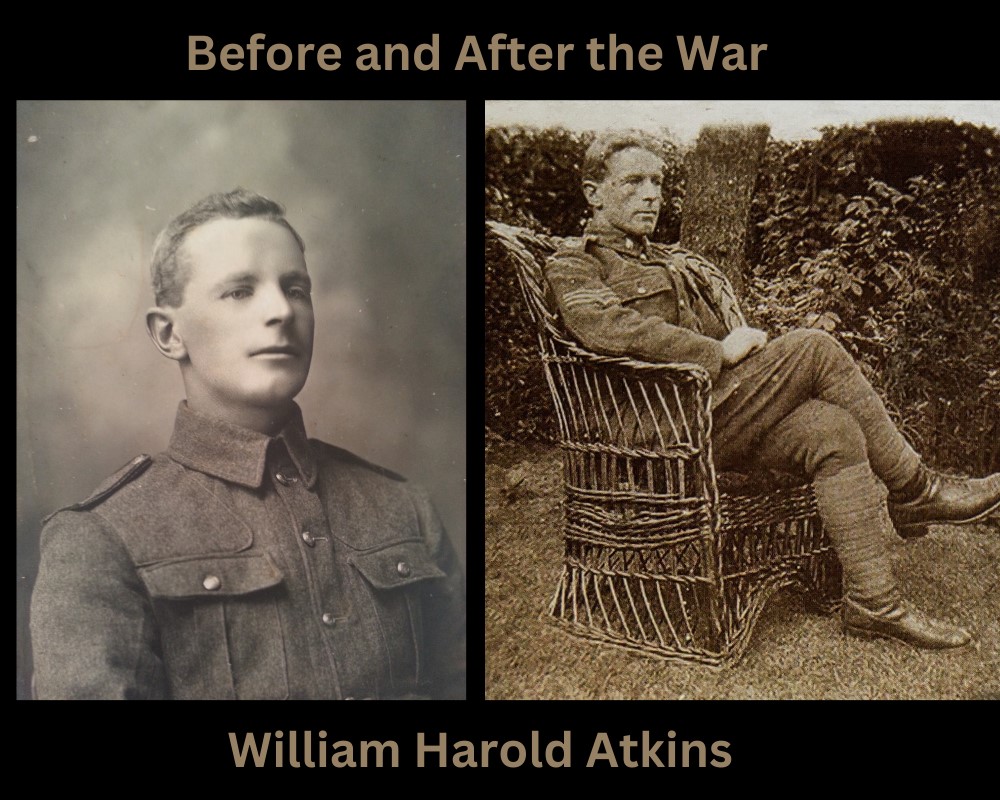
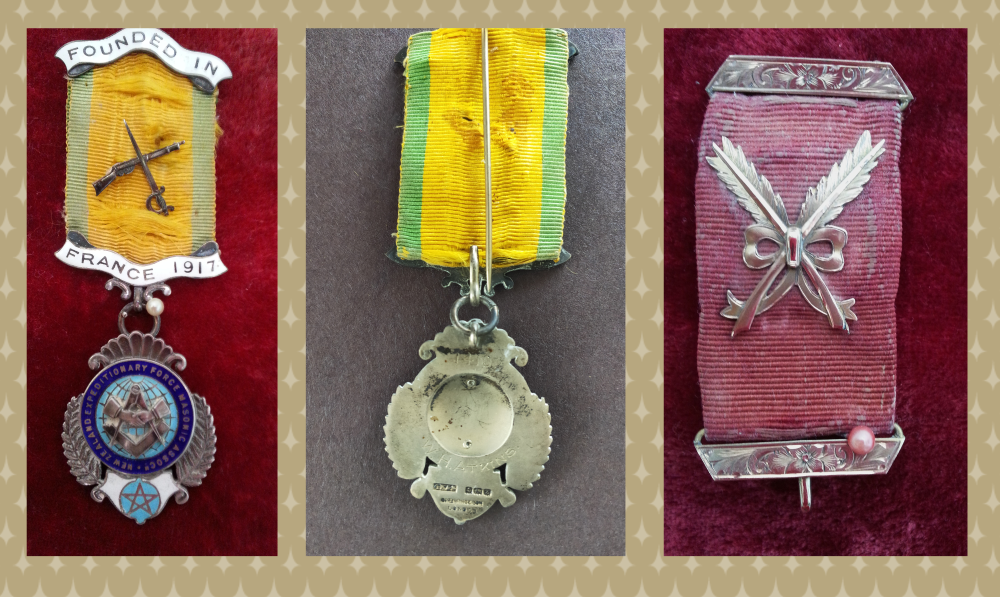
A colourful medal caught my attention among a collection of war medals belonging to my grandfather William Harold Atkins, ‘Pa’ to the family, and simply ‘Number 12/2204’ to the War office. 12/2204 was one of 98,950 who served with the New Zealand (NZ) Expeditionary Force in World War 1 (WW1)[1], he served 4 years and 6 days: almost the length of the war. This medal, a Freemasons “jewel”, tells a story of both battlefield meetings of the Freemasons and a part of Pa’s war journey.
Despite his lengthy service only slivers of information remain of Pa’s war experiences, he shared little with his family. The collection of war medals is a rare and visible legacy. Heirlooms displayed on a fading red velvet background; and polished every ANZAC day by his family. The display prompts inquiry and exploration by his descendants of which I am one.
The medal itself tells a story. A combination of symbols hangs from a now-tattered green and gold corded ribbon. The French government permitted the use of this ribbon, the French Médaille militaire, [2] for those who served in France [3]. The military symbol of a crossed sword and rifle is attached to the ribbon framed by the words “Founded in – France 1917” written across a white enamelled banner. This echoes a family recollection of Pa saying he had attended a Freemasons’ meeting held on the battlefields of France.
‘New Zealand Expeditionary Force Masonic Assoc.’ is engraved on a royal blue border, encased by curved fronds of the native NZ Ponga, more universally known as the Silver Fern, unmistakably displaying the soldier’s country of origin. Inside this border on a turquoise-coloured background are etched the longitude and latitudinal lines of a globe over which are the Freemasons’ symbols of a compass, square and handshake.[4] Further Freemasonry symbols sit at the base of the medal where another white enamel ribbon displays the five-pointed star. Recognisable symbols that unite members and remind them of the universal principles of Freemasonry. [5]
Hanging from the lower banner is an intricate setting that includes what appears to be a small pearl, with a second empty setting, sitting over a stylised crown. While suggesting an office-bearer, the meaning of this pearl was not discovered. A pink pearl-like jewel also appears on a second red Freemasons medal, (See Fig 1 above) it is suggested: “the Red Jewel is associated with the Royal Arch he may have been Secretary for more than 10 years to be presented with a Secretaries jewel.” [6]
The back of the medal yields further information. It is plain except for an engraved name and number: 1410 and W.H. Atkins. This again reinforces that the medal was for service in France. It is understood there are now over 500 Jewels now identified, and more than three thousand NZ Freemasons served overseas. [6] The hallmark while difficult to decipher confirms the medal is silver dated 1924-25. Words I first read as Kensington are revealed to be ‘Kenning and Son London’, [7] who have a long history of making Masonic regalia. Following WW1 a NZ company Goldstein and Moller replaced Kenning and Son to produce the medals locally.
When mooted in 1918 it was agreed this medal/jewel would be “…restricted to men who have served overseas in a military capacity.”[8] [9] Whether Pa was a member before the war is possible, but not known. The first Masonic lodge in NZ [10] had formed in 1842, and in England, the history of Freemasons could be traced back to the 18th century.[11] Pa had emigrated from England to NZ in 1910 at 22 years of age making it possible for him to have been a member in either or both countries.
After the war when injuries prevented work as a carpenter and labourer Pa learned to write with his (non-dominant) right hand and studied Accountancy. It is believed he may have attended Freemasons meeting while he studied in Auckland after the war. He was also active in the newly formed Returned Services Association and held the position of Secretary.
While studying in Auckland a group of close friends moved to the Far North and convinced Pa to go with them. This tightly bonded group of men had met when emigrating to NZ and soldiered together through the war years. Once settled in the North Pa became involved in a range of community and public service roles including Justice of the Peace, Town Clerk, and member of the Hospital Board. It was here in later years his youngest son would recall him regularly attending meetings at the Freemasons Lodge in his hometown Kaitaia, still a small, isolated town in the Far North of NZ.
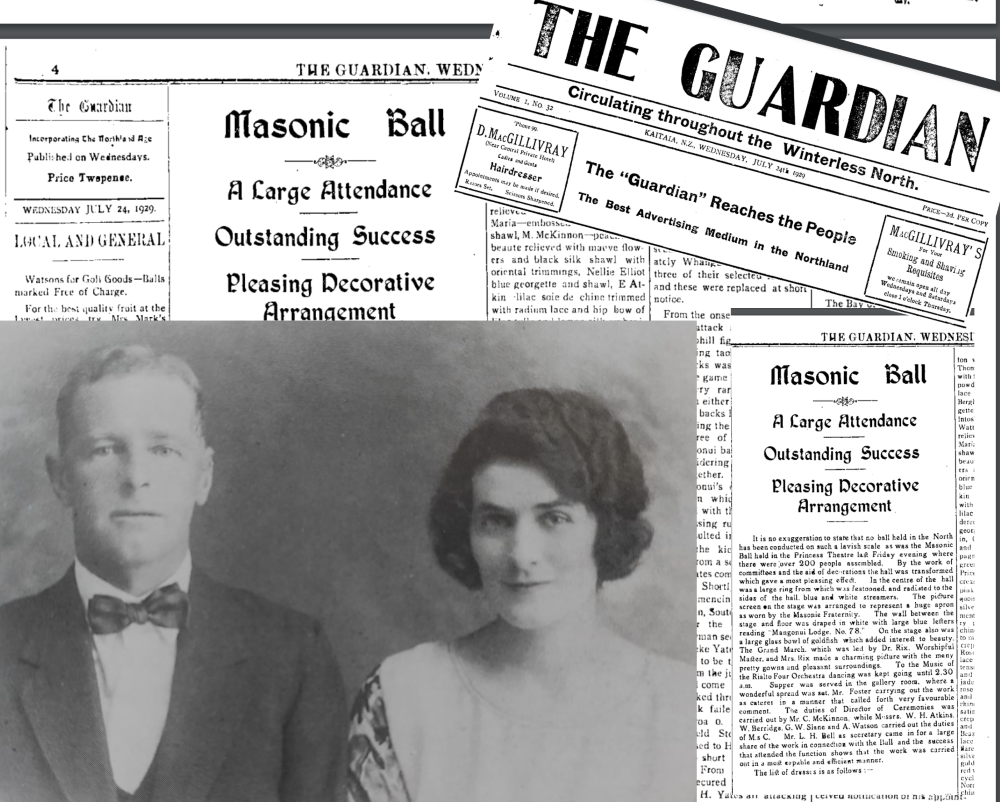
It was here in Kaitaia in 1929 the first Masonic Ball in the Far North was held. Effusively described in the local news – “it is no exaggeration to state that no ball in the north has been conducted on such a lavish scale as was the Masonic Ball held in the Princess Theatre…”. In the detail that follows W.H. Atkins is mentioned as one of the Master of Ceremonies, and amongst a lengthy list describing the fashions of the night Mrs W H Atkins was described as wearing “Blue velvet and georgette”. [12] A long way from life as a serving soldier.
Many soldiers from NZ in WW1 had been born in England or had close connections. Freemasonry bonds between the allied countries were strengthened, during WWI. [13] (pg 62-3). The number of men joining Lodges throughout the war highlights the benefit of the association for the soldiers; 75 men expanded to approximately 1,700 men through the war years. [3] Associations met in Egypt, Palestine, France, and back in England in the camps and hospitals.
Dating back to the 18th century, history shows a long association between the military and Freemasonry. This link is thought to be enhanced by the principles of brotherhood, universality, and egalitarianism bonding soldiers together. The exact beginnings and history of Freemasonry continues to be debated, though “…the general consensus among Masonic scholars is that they lie with the medieval stonemasons”. [11] It has been suggested that Freemasons travelled out across the world with the British Empire [14] as it spread its colonial reach, likely assisted by the movement of the army and navy.

Despite a desire to learn more about Pa, the more I learned I was troubled by my belief that women were excluded from the Freemasons. It was a surprise to discover there was some evidence of women belonging. Elizabeth Aldworth [15] was the first woman Freemason recorded in the 1700s and much later a Lodge The Order of Womens’ Freemasons lodges [16][17] was established in England in the early 1900s. The Order of the Eastern Star began in the 18th century when Dr Rob and Charlotte Morris began the order espousing the principles of Charity, Truth and Loving Kindness. This affiliated group was open to men and women and included groups in NZ.[18] While not inclusive, it seemed women were not excluded from the Freemasons.
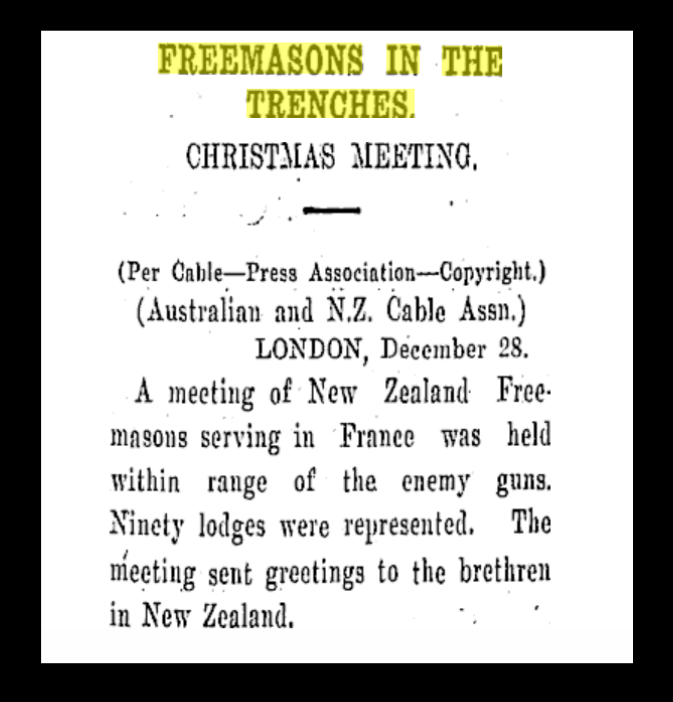
Searching for evidence of Pa’s participation in WW1 Freemasons meetings was not successful, yet I did discover links that brought me closer. The first was a newspaper headline in the North Otago Times in December 1916 that read “Freemasons in the Trenches – Christmas Meeting”. [19] The news clip – a short cable – reported a Christmas meeting in France where men from ninety lodges around NZ gathered “within range of enemy guns”. Corporal William Harold Atkins had been transferred from the Gallipoli peninsula to France by Christmas 1916, so it is possible he could have attended.
The second discovery was a photograph taken at a meeting in Authiers, France, entitled “Meeting of the New Zealand Masonic Association held in the field near the firing line” [20]. Both the image and its title brought the vision of a battlefield meeting to life.
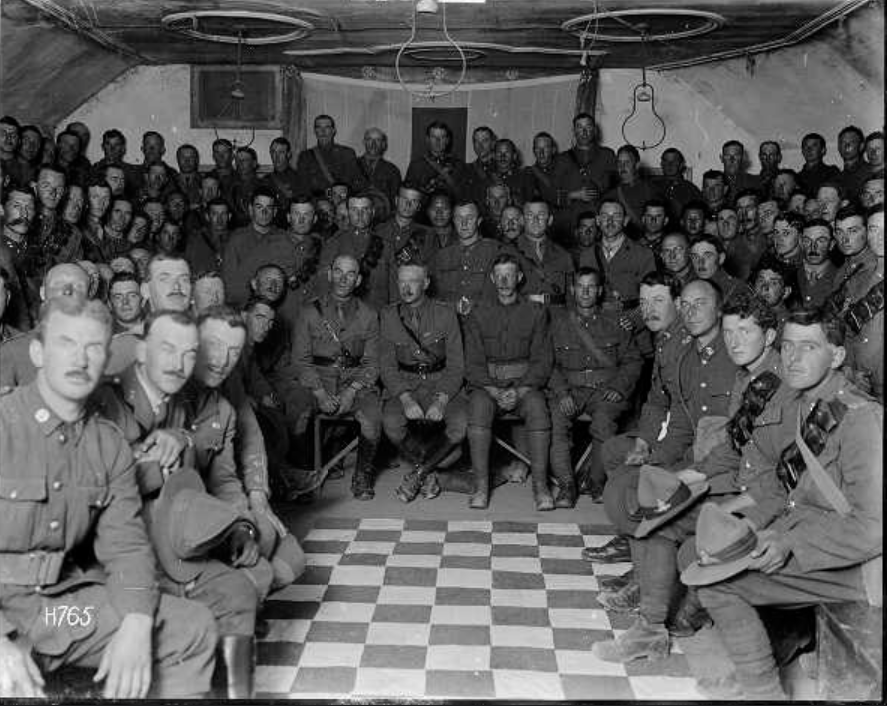
I could imagine Sergeant William Harold Atkins at such a meeting. A handsome man with sharp fine features, fair hair, and bright blue eyes, sitting amidst the sounds of war, cloistered in the warmth of a large tent, and tightly surrounded by other men; other Freemasons.
It seems such a group of men would find order and comradery through the familiar rituals and fellowship of a Freemasons meeting. Forgotten for a short time the mud, the foul smell, the itch of lice biting flesh, the wounded and dying friends, the killing of men, the dreams of home. Somewhere in France, for a short time, all eyes are fixed firmly on the small square of chequered floor symbolising the Tesselated pavement at the front and the rituals that followed.
Combing the faces in the image, I knew Pa could not have been present at this meeting, his active service had ended at Ypres in October 1917 when a gunshot wound led to the amputation of his left arm.
Pa finally returned to NZ on the first ship to sail the English Channel after the Armistice was signed. The hospital ship ‘Ruahine’ carried over 700 officers, Nurses, and men when it sailed in December 1918. [22] With the knowledge of emigrating to NZ on this same ship eight years earlier, this would likely have been a poignant voyage for Pa.
Despite serving from 1915 to 1917, first in Gallipoli and later in France, he shared little of his experience with family. Exploring one glimpse through this colourful medal brings a small window of his story to life. Hopefully creating an opportunity to discover more of the life of William Harold Atkins in the future.

NOTE: I am indebted for the help and research provided by Gordon Sylvester RH who generously spent time researching both the Freemasons links and war years of William Harold Atkins.
This writing was assisted and encouraged by the wonderful Curious Descendants Club – writing your ancestors’ stories.
Any errors and gaps in this story are mine. I welcome comments and further information. Please contact me: findingappoo@gmail.com
BIBLIOGRAPHY
[1] ‘First World War by the numbers’. https://nzhistory.govt.nz/war/first-world-war-by-numbers (accessed Feb. 02, 2023).
[2] ‘Médaille militaire’, Wikipedia. Dec. 01, 2022. Accessed: Jan. 12, 2023. [Online]. Available: https://en.wikipedia.org/w/index.php?title=M%C3%A9daille_militaire&oldid=1124975822
[3] G. Sylvester R.H., ‘World War 1 and Freemasonary’. Apr. 2017. Accessed: Jan. 06, 2023. [Online]. Available: https://themasons.org.nz/cdiv/docs/ww1andfreemasonry.pdf
[4] ‘Behind the Masonic Symbols: The Square and Compasses – Freemasonry’. https://www.freemason.com/masonic-symbols-square-compasses/ (accessed Nov. 01, 2022).
[5] ‘The Meaning Behind 15 Common Masonic Symbols | George H LilleyTM️’. https://www.ghlilley.com.au/blogs/news/freemason-symbols (accessed Nov. 01, 2022).
[6] Gordon Sylvester, ‘Correspondence with Gordon Sylvester’. Feb. 01, 2023.
[7] ‘About George, Kenning & Son’, George, Kenning & Son. https://gksmasonic.com/about-george-kenning-son/ (accessed Jan. 10, 2023).
[8] ‘Inside the wartime fraternity: Freemasonry in New Zealand during World War 1’, Freemasonary Today, Mar. 07, 2017. Accessed: Nov. 02, 2022. [Online]. Available: https://www.freemasonrytoday.com/features/freemasonry-in-new-zealand-during-world-war-1
[9] K. & Son, Medal, membership. 1914. Accessed: Oct. 28, 2022. [Online]. Available: https://commons.wikimedia.org/wiki/File:Medal,_membership_(AM_795025-5).jpg
[10] ‘History of Freemasons In NZ’. https://freemasonsnz.org/history (accessed Jan. 31, 2023).
[11] ‘History of Freemasonry | United Grand Lodge of England’. https://www.ugle.org.uk/discover-freemasonry/history-freemasonry (accessed Jan. 06, 2023).
[12] ‘Masonic Ball’. [Online]. Available: https://paperspast.natlib.govt.nz/imageserver/newspapers/P29pZD1OT1JBRzE5MjkwNzI0JmdldHBkZj10cnVl
[13] ‘Freemasonry Today – Spring 2017 – Issue 37 by UGLE – Issuu’. https://issuu.com/freemasonrytoday/docs/fmt_37_spr_17_non_editable (accessed Jan. 10, 2023).
[14] J. Harland–Jacobs, ‘Hands Across the Sea: The Masonic Network, British Imperialism, and the North Atlantic World’, Geogr. Rev., vol. 89, no. 2, pp. 237–237, Apr. 1999.
[15] ‘Elizabeth Aldworth’, Wikipedia. Nov. 10, 2022. Accessed: Jan. 31, 2023. [Online]. Available: https://en.wikipedia.org/w/index.php?title=Elizabeth_Aldworth&oldid=1121125082
[16] ‘Women Freemasons’. https://www.ugle.org.uk/become-freemason/women-freemasons (accessed Nov. 01, 2022).
[17] ‘The Order of Women Freemasons | Womens Freemasonry | Nationwide’. https://www.owf.org.uk/ (accessed Nov. 01, 2022).
[18] ‘Order of the Eastern Star’, Wikipedia. Jan. 31, 2023. Accessed: Feb. 03, 2023. [Online]. Available: https://en.wikipedia.org/w/index.php?title=Order_of_the_Eastern_Star&oldid=1136720079
[19] ‘Freemasons in the Trenches. , Freemasons in the Trenches.’, North Otago Times, vol. CIV, no. 13766, p. 4, Dec. 30, 1916.
[20] ‘Meeting of the New Zealand Masonic Association held in the field near the firing line, Authie, World War I’. https://ndhadeliver.natlib.govt.nz/delivery/DeliveryManagerServlet?dps_pid=IE503179&dps_custom_att_1=emu (accessed Oct. 28, 2022).
[21] ‘The Checkered Flooring | Freemason Information’, Mar. 07, 2009. https://freemasoninformation.com/banks-of-the-euphrates/the-checkered-flooring/ (accessed Nov. 01, 2022).
[22] ‘Ruahine Arrived. , Ruahine Arrived.’, Auckland Star, vol. L, no. 161, p. 5, Jul. 08, 1919.